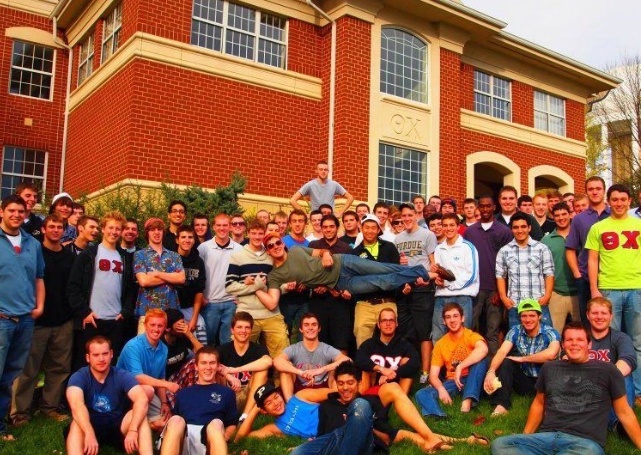The stated purpose of the organization was to aid its members to better fit themselves for their duties as citizens, as well as to afford more congenial surroundings while in college.
The pin designed by the founders was shaped to resemble a spherical triangle. The Greek letters Sigma, Tau, and Alpha were etched on a background of black enamel, which was bordered by an alternate crown set of pearls and rubies. A diamond blazing from the center of the pin represented the “Star of Hope.”
Desiring to be associated with a national fraternity, the men of Sigma Tau Alpha, on November 13, 1919, dispatched a petition to the Grand Chapter of Theta Chi Fraternity seeking absorption of Sigma Tau Alpha. Shortly thereafter, Brother Green from Chicago came to inspect the chapter. Also, an informal dance was held on February 6, 1920 and brothers from the Rho Chapter at the University of Illinois were house guests as they continued the investigation. On February 21, 1920, the Grand Chapter of Theta Chi approved the petition. Word was received on February 27 of the approval. The dates for installation of the chapter were set for March 26 and 27.
On Friday, March 26 the formal opening ceremonies began began at nine o’clock and 39 members of Sigma Tau Alpha became charter members of the Alpha Delta Chapter of Theta Chi.
Since that day in 1920, the chapter has owned five houses: 1018 State, 27 Russell, 608 Waldron. This new home was first occupied in the fall of 1927 and was built at a cost of $85,000. The house was lost during the Depression Era of the 1930’s. The fourth house was located at 359 Vine, and the present house is located at 800 David Ross Rd.
The history of Delta Sigma Lambda fits here as an insert of 1936-1937. In 1937 following the merger of Delta Sigma Lambda with Theta Chi, the chapter again had a large house and chapter. World War II had a large impact on the fraternity system. Membership was so depleted that operation nearly ceased. In 1943, the house was leased to the Navy for the duration of the war, and Alpha Delta’s six remaining actives relocated to the Pi Kappa Alpha house along with the men of six other fraternities. In 1944, a fire at this house destroyed the third floor, along with most of the Chapter’s valuable records and coveted trophies.


